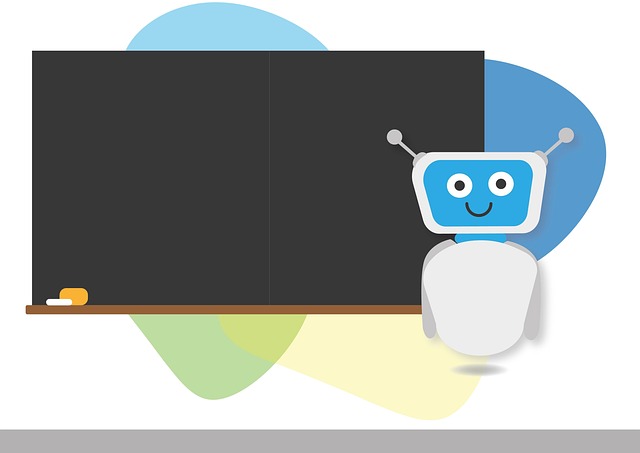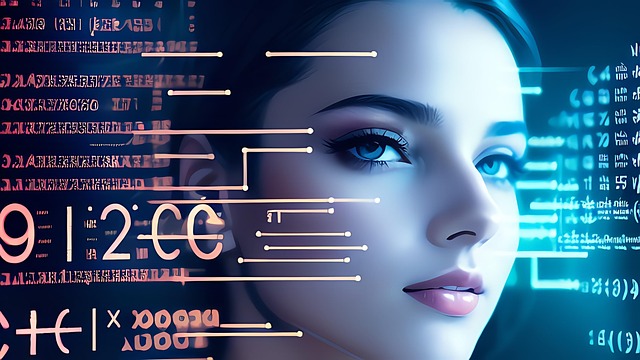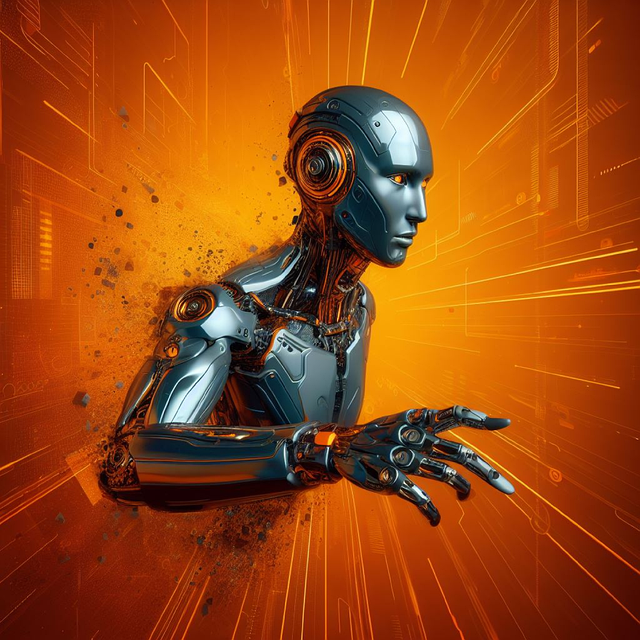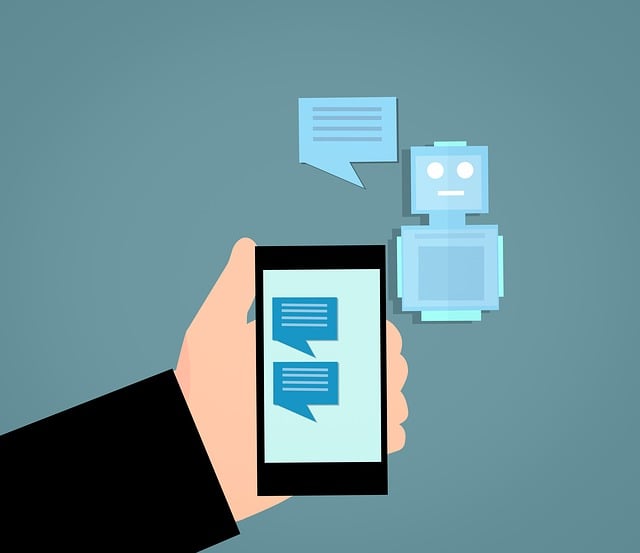AI Chatbots: Adaptive Evolution Shaping Conversational Future

AI chatbot evolution from rule-based to adaptive: Machine learning, deep learning, and natural langu…….
We are At Your Service
The digital revolution has given birth to a fascinating evolution in artificial intelligence (AI), particularly in the realm of AI assistants, which have transformed from simple automated bots to sophisticated companions that mimic human-like interactions. This article delves into the intricate journey of AI assistants, exploring their transition from rudimentary tools to intelligent entities capable of fostering meaningful connections with users. By tracing this evolution, we gain insights into the technological advancements, societal impacts, and future prospects shaping the landscape of AI-human interaction.
The concept of AI assistants is not merely about automation; it involves creating digital companions that understand, respond, and assist individuals in their daily lives. This transformation has profound implications, from enhancing productivity and accessibility to reshaping how we interact with technology. As AI assistants become more prevalent, understanding their evolution is crucial for businesses, researchers, and policymakers alike, ensuring responsible development and optimal utilization.
The evolution of AI assistants refers to the progressive development of software systems designed to interact with humans in a conversational manner, offering assistance and information. These assistants leverage natural language processing (NLP), machine learning (ML), and other AI techniques to comprehend user queries and generate contextually relevant responses.
Key components driving this evolution:
Natural Language Processing (NLP): Enables AI assistants to interpret human language, allowing for meaningful conversations. NLP advancements in areas like intent recognition, entity extraction, and sentiment analysis have significantly improved the accuracy of understanding user requests.
Machine Learning (ML): Powers the adaptive behavior of AI assistants. ML algorithms enable assistants to learn from interactions, improve response quality over time, and personalize user experiences based on preferences and behaviors.
Context Awareness: A critical aspect, allowing assistants to maintain context during conversations, ensuring coherent and relevant responses. Contextual understanding involves tracking user history, preferences, and environmental cues.
Voice User Interfaces (VUI): The medium through which users interact with AI assistants, primarily via voice commands. VUIs facilitate hands-free interaction, making assistants more accessible and convenient to use.
Personalization: Customizing the assistant’s behavior and responses to individual users’ preferences, interests, and needs enhances user satisfaction and engagement.
The concept of AI assistants can be traced back to the early days of computer science, with early forms appearing as rule-based systems that followed predefined commands. These early bots were limited in their ability to understand natural language and adapt to user needs.
Milestones in the evolution:
1950s-1960s: The inception of AI research laid the foundation with pioneers like Alan Turing proposing the idea of machine intelligence. Early AI assistants, such as ELIZA (1966), a chatbot designed to mimic Rogerian psychotherapy, introduced basic conversational interaction.
1980s-1990s: The development of expert systems and rule-based agents marked a step forward. Systems like X.25 and early virtual assistants demonstrated the potential for computer-human interaction but lacked contextual understanding and personalization.
2000s: The rise of web 2.0 and advancements in NLP brought about more sophisticated AI assistants. Apple’s Siri (2011) and Google Now (2013) introduced voice-activated assistants, while virtual agents like Chatbot.com (2016) showcased improved conversational abilities.
2010s-Present: The advent of deep learning and large language models revolutionized AI assistants. Models like IBM’s Watson (2017) and OpenAI’s GPT series (2020 onwards) enabled more human-like interactions, context awareness, and adaptability. Today’s assistants can engage in complex conversations, provide personalized recommendations, and perform a wide range of tasks.
The evolution of AI assistants is intrinsically linked to broader technological trends, including:
Internet of Things (IoT): As IoT devices become more prevalent, AI assistants play a pivotal role in connecting and managing these devices, offering centralized control and automation.
Cloud Computing: Cloud-based AI services enable scalable and accessible development, deployment, and training of assistant models, fostering innovation and collaboration.
Data Analytics: The vast amounts of data generated by user interactions power ML algorithms, enabling assistants to learn and adapt to user preferences and behaviors.
Mobile Revolution: Smartphones have democratized access to AI assistants, making them ubiquitous and always available, transforming how we interact with technology daily.
The influence of AI assistants is not limited to any specific region; their impact is felt worldwide, shaping digital experiences and interactions.
Market Penetration: AI assistants are rapidly gaining adoption across diverse sectors, including healthcare, finance, retail, and education. According to a 2023 report by Market Research Future (MRFR), the global AI assistants market is projected to reach USD 145.6 billion by 2027, growing at a CAGR of 28.5%.
Regional Variations: While North America and Europe have been early adopters, Asia-Pacific is witnessing rapid growth due to factors like technological readiness and government support. China, in particular, has emerged as a hub for AI development, with initiatives like Baidu’s DuerOS driving the adoption of voice assistants.
Language Localization: As AI assistants become more personalized, there is a growing trend to localize them for specific languages and dialects. This ensures cultural relevance and improves user engagement, particularly in regions with diverse linguistic landscapes.
North America: Companies like Amazon (Alexa), Apple (Siri), and Google (Google Assistant) have dominated the market, offering extensive capabilities and integrations. The US government’s support for AI research further fuels advancements.
Europe: European countries are investing in AI ethics and regulation, ensuring responsible development. Initiatives like the European Union’s AI Act aim to establish guidelines for high-risk applications, including AI assistants.
Asia-Pacific: China’s AI industry is booming, with companies like Alibaba (Tmall Genie) and Tencent (WeChat Assistant) offering integrated AI solutions. India, too, is witnessing growth, with local assistants tailored to Hindi and other regional languages.
The economic implications of AI assistants are profound, impacting various sectors and driving market dynamics.
Competition: The market is highly competitive, with numerous players offering AI assistant solutions. This competition drives innovation, improves functionality, and lowers costs, benefiting consumers.
Integrations and Partnerships: AI assistants often serve as central hubs for IoT ecosystems, attracting investments from tech giants and startups alike. Integrations with smart home devices, wearables, and other services create new revenue streams.
Market Segmentation: Assistants cater to diverse user segments, from general-purpose consumers to enterprise clients. Customized solutions for specific industries, such as healthcare or finance, command premium prices.
Venture Capital (VC) Funding: Startups developing AI assistants have attracted significant VC investments. According to CB Insights, AI startups received over $14 billion in funding between 2016 and 2020, with a notable rise in investment post-2019.
Corporate Inversions: Major tech companies are acquiring AI-focused startups to enhance their assistant capabilities. For instance, Google’s acquisition of Dialogflow (2017) and Apple’s purchase of Siri and Voice User Interface technologies (2010) demonstrate strategic investments in this space.
Productivity Enhancement: AI assistants automate routine tasks, freeing up human resources for more complex work. This leads to increased productivity in various sectors, reducing operational costs and improving efficiency.
Personalized Services: The ability to offer personalized experiences based on user data creates new business models. From tailored recommendations to customized assistance, these services can drive revenue and customer loyalty.
Job Market Impact: While AI assistants automate certain tasks, they also create new job opportunities in development, training, and maintenance. The shift towards more skilled roles ensures a more resilient job market.
Technological breakthroughs have been pivotal in the evolution of AI assistants, driving their capabilities and functionality.
Deep Learning: Deep neural networks enable assistants to understand complex language structures, generate coherent responses, and learn from user interactions. Models like Transformer architectures (e.g., GPT) have revolutionized NLP tasks.
Large Language Models (LLMs): LLMs, trained on vast datasets, exhibit remarkable language understanding and generation capabilities. They can engage in open-domain conversations, summarize text, translate languages, and perform diverse textual tasks.
Contextual Understanding: Advances in memory networks and attention mechanisms allow assistants to maintain context across lengthy conversations, providing relevant and coherent responses.
Multimodal Interaction: The integration of computer vision and speech recognition enables assistants to interpret user inputs from various modalities, enhancing their versatility.
Emotion Recognition: Advanced emotion AI can enable assistants to recognize and respond appropriately to human emotions, fostering more empathetic interactions.
Common Sense Reasoning: Developing common sense reasoning in AI assistants will allow them to understand and navigate real-world scenarios, improving their adaptability and decision-making abilities.
Explainable AI (XAI): Enhancing transparency through XAI ensures that users trust the assistant’s recommendations and decisions, building accountability and ethical practices.
As AI assistants become more integrated into daily life, policy frameworks and regulations are essential to address ethical concerns and ensure responsible development.
EU AI Act: The European Union’s proposed AI Act aims to create a legal framework for high-risk AI applications, including requirements for risk assessment, transparency, and human oversight. It sets out categories for AI systems based on their risks and establishes a compliance assessment procedure.
US Privacy Laws: Regulations like the California Consumer Privacy Act (CCPA) and the General Data Protection Regulation (GDPR) in Europe impose data privacy and security standards for companies handling user data, including AI assistants.
Ethical Guidelines: Organizations like the IEEE and UN have published ethical guidelines for responsible AI development, emphasizing fairness, transparency, accountability, and human autonomy.
Transparency and Accountability: Regulatory frameworks encourage developers to build transparent and explainable AI assistants, ensuring users understand how decisions are made. This promotes trust and addresses concerns about bias and discrimination.
Data Governance: Policies governing data collection, storage, and use ensure user privacy and security, prompting developers to adopt secure practices for handling sensitive information.
Human Oversight: Regulations emphasize the need for human control and oversight of AI systems, preventing unintended consequences and ensuring accountability.
Despite their potential, AI assistants face several challenges and criticisms that must be addressed for their widespread adoption and acceptance.
Data Bias: AI models trained on biased data can perpetuate and amplify existing societal biases, leading to discriminatory outcomes. Ensuring diverse, representative, and high-quality training data is crucial.
Privacy Concerns: The vast amounts of user data collected by assistants raise privacy issues. Striking a balance between personalized experiences and user privacy protection is an ongoing challenge.
Lack of Contextual Understanding: While context awareness has improved, AI assistants still struggle with nuanced language and cultural contexts, leading to inaccuracies and inappropriate responses.
Job Displacement: Automation through AI assistants may displace certain jobs, requiring reskilling efforts and policy interventions to address potential economic impacts.
Diverse and Representative Data: Implementing data diversity initiatives ensures that training datasets reflect the real-world population, reducing bias and improving fairness in AI models.
Differential Privacy Techniques: Applying privacy-preserving techniques during data collection and processing can mitigate privacy risks while allowing for useful data analysis.
Contextual Training: Enhancing training methods to include diverse linguistic and cultural contexts improves assistants’ ability to understand and respond appropriately.
Human-in-the-Loop Systems: Incorporating human feedback loops and oversight mechanisms ensures that AI assistants adhere to ethical guidelines and learn from mistakes, fostering continuous improvement.
Real-world applications of AI assistants demonstrate their transformative potential across various sectors.
AI Assistant: Babylon Health (UK)
Application: Babylon’s virtual health assistant provides personalized healthcare services, offering medical advice, booking appointments, and managing chronic conditions. It utilizes NLP to understand user symptoms and provides evidence-based recommendations.
Impact: The assistant has seen over 10 million conversations, reducing hospital visits and improving patient access to care. It has also facilitated early disease detection and management, contributing to better health outcomes.
AI Assistant: Sephora’s Virtual Artist (US)
Application: This AI-powered virtual try-on tool allows customers to virtually test cosmetics products. Using computer vision, it analyzes users’ facial features and suggests suitable makeup options.
Impact: The Virtual Artist has enhanced the online shopping experience, increasing customer engagement and sales. It provides personalized recommendations, fostering a unique and interactive brand experience.
AI Assistant: Duolingo (Global)
Application: Duolingo’s language learning assistant offers personalized language lessons, adapts to users’ proficiency levels, and provides real-time feedback. It utilizes gamification techniques to engage learners.
Impact: With over 500 million users, Duolingo has made language learning accessible and enjoyable. The AI assistant ensures tailored learning experiences, contributing to improved language acquisition rates.
The evolution of AI assistants is set to accelerate, driven by technological advancements, market demands, and policy frameworks.
Enterprise Solutions: AI assistants will become integral to enterprise operations, offering personalized assistance to employees and customers, streamlining workflows, and enhancing decision-making.
Healthcare and Wellness: Advanced AI assistants will play a pivotal role in remote patient monitoring, chronic disease management, and personalized wellness coaching, improving healthcare accessibility and outcomes.
Smart Cities: In urban environments, AI assistants can facilitate citizen services, transportation, and infrastructure management, enhancing city dwellers’ quality of life.
Conversational AI in VR/AR: Integrating AI assistants into virtual reality (VR) and augmented reality (AR) experiences will create immersive interactive environments for education, entertainment, and training.
AI-driven Content Creation: Assistants will collaborate with users to generate creative content, from writing articles to designing personalized fashion looks, empowering individuals in artistic endeavors.
Explainable AI (XAI): As ethical considerations gain prominence, XAI will become more prevalent, ensuring that AI assistants’ recommendations and decisions are transparent and trustworthy.
The evolution of AI assistants is a testament to human ingenuity and technological advancement. From their early beginnings to the sophisticated systems of today, these assistants have transformed how we interact with technology. As they continue to grow in capabilities and adoption, addressing challenges and shaping policies will be crucial for maximizing their benefits while mitigating potential risks. The future holds immense possibilities for AI assistants to enhance our lives, work, and interactions, paving the way for a more intelligent and connected world.

AI chatbot evolution from rule-based to adaptive: Machine learning, deep learning, and natural langu…….

AI assistants have evolved from rule-based systems to adaptive companions leveraging machine learnin…….

The evolution of AI chatbots began with simple question-answering machines, driven by NLP advancemen…….

AI chatbots, powered by advanced NLP, transform human-machine interaction with intuitive dialogues,…….

AI chatbots have evolved from simple rule-based systems to advanced assistants using machine learnin…….

AI customer service has evolved from clunky early chatbots to sophisticated systems using machine le…….

AI assistants have evolved from rule-based bots to dynamic entities with NLP and ML capabilities, un…….

Artificial intelligence (AI) assistants have evolved from basic automation tools to sophisticated co…….

AI chatbots have evolved from rule-based systems to sophisticated digital assistants powered by NLP…….

AI chatbots are revolutionizing customer service with 24/7 support and accurate information, handlin…….